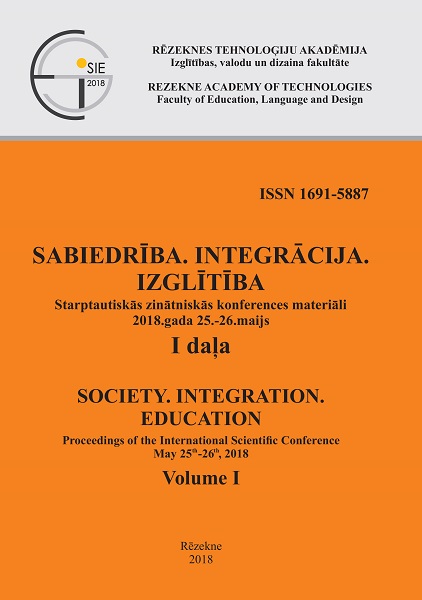TEACHING ENTREPRENEURSHIP THROUGH A CLIL APPROACH IN RUSSIAN TECHNICAL UNIVERSITIES
DOI:
https://doi.org/10.17770/sie2018vol1.3189Keywords:
EMI (English as Medium of Instructions), CLIL, entrepreneurship, Entrepreneurial Leadership, teaching techniques, Masters’ Programme “Entrepreneurs for Tomorrow”Abstract
In recent decades, increasing numbers of EMI (English as Medium of Instructions) courses have been added to university course offerings in countries where English is not the first language, as a way of supporting university internalization and addressing the global status of English. However, some studies argue that EMI courses might affect the overall learning of course content because of students' poor lecture comprehension and passive engagement in class. In order to facilitate student engagement and improve learning experiences in EMI courses, the authors introduce a CLIL approach that would facilitate students' overall learning in entrepreneurship. By focusing rather on the content, students acquire the target language unconsciously. Learning a language through content does not only increase the students’ motivation but it also improves the students’ performances, both in language and content. This article demonstrates the possibility of combining the subject Entrepreneurial Leadership and CIL, and it intends to explore possible benefits and obstructions. During the research it became evident that the students’ interest in Entrepreneurial Leadership which was realized in the frame of Masters’ Programme “Entrepreneurs for Tomorrow” as well as their concentration increased, mainly due to the use of different teaching techniques employed and partly due to use of English as the language of instruction. Further issues raised in the field of CLIL Entrepreneurial Leadership will be discussed in the empirical part and in the curriculum analysis.
References
Application Form TEMPUS IV – 6th Call for proposals Joint Projects. Structural Measures. Submission number: 544370-TEMPUS-1-2013-1-NL-TEMPUS-JPHES. Retrieved from: http://eacea.ec.europa.eu/eforms/index_en.php
Baker, C. & Jones, S. P. (1998). Encyclopedia of Bilingualism and Bilingual Education. Clevendon: Multilingual Matters.
Coyle, D., Hood, P. & Marsh, D. (2010). CLIL: Content and Language Intergrated Learning. Cambridge: CUP.
Commission of The European Communities (2004-2006): Promoting Language Learning and Linguistic Diversity: An Action Plan 2004-2006. Retrieved from http://www.saaic.sk/eu-label/doc/2004-06_ en.pdf.
Dale, L., van der Es, W., & Tanner, R. (2011). CLIL Skills. Leiden: European Platform (Internationalising education).
Dearden, J. (2014). English as a medium of instruction – a growing global phenomenon: Phase 1 interim report. British Council. Retrieved from http://www.britishcouncil.org/education/ihe
Dollinger, M. J. (2008). Entrepreneurship : strategies and resources. 4th ed. Marsh Publications LLC.
Gibb, A., Haskins, G., & Robertson, I. (2013). Leading the entrepreneurial university: Meeting the entrepreneurial development needs of higher education institutions. Universities in Change, 9-45. New York: Springer.
Grabe, W. & Stoller, F. (1997). Content-Based Instruction: Research Foundations. Retrieved from http://www. carla.umn.edu/cobaltt/modules/principles/grabe_ stoller1997/READING1/foundation.htm
Graddol, D. (2006). English Next. British council. Retrieved from https://englishagenda.britishcouncil.org/sites/default/files/attachments/books-english-next.pdf
Harrop, E. (2012). Content and Language Integrated Learning (CLIL): Limitations and possibilities. Encuentro, 21, 57-70.
Kovacs, J. (2014). CLIL – Early competence in two languages. In: The world at their feet: Children’s early Competence in Two Languages through Education (pp.15-97). Budapest: Eötvös József Könyvkiadó.
Kuratko, D. F. & Hodgetts, R. M. (1998). Entrepreneurship: A Contemporary Approach. 4th ed., Ft. Worth, TX: HBJ, Dryden Press.
Kuratko, D. F. (2005). The emergence of entrepreneurship education: Development, trends and challenges. Entrepreneurship Theory and Practice, 29, 5, 577-597.
Kuratko, D. F. (2007). Entrepreneurial Leadership in the 21st Century. Journal of Leadership and Organizational Studies, No 13, 4.
Lin, A.M.Y. (2016). Language Across the Curriculum & CLIL in English as an Additional Language (EAL) Contexts: Theory and Practice. Springer.
Lopukhova, Y. V., Yurina, M. Y., Makeeva, E. Y., Spaubeck, J. M. & Vatolkina, N. Sh. (2017). International master thesis: requirements and guidelines (for masters’ thesis prepartion and defence). Samara, SanGTU.
Lopukhova, Y. and Suchkov, D. (2016). Aspects of preparation and evaluation of international master thesis in the programme “Entrepreneurs for Tomorrow” in the framework of Tempus project. New strategies of learning activities assessment: International Conference Proceedings (pp. 242-252). Samara, SGASU.
Makeeva, E. and Spaubeck, J.M. (2016). International master thesis: structure and content requirements in the framework of the programme “Entrepreneurs for Tomorrow” (Tempus IV Project) New strategies of learning activities assessment: International Conference Proceedings (pp. 222-229). Samara, SGASU.
Marsh, D. (2002). CLIL/EMILE – The European Dimension: Actions, Trends & Foresight Potential. Brussels: European Commission.
Marsh, D. (2012). Content and Language Intergrated Learning (CLIL). A developmet Trajectory. Cordoba: University of Cordoba.
Marsh, D., Maljers, A. & Hartiala, A.-K.. (2001). Profiling European CLIL Classrooms – Languages Open Doors. Jyvaskyla: University of Jyvaskyla.
Mehisto, P., Marsh, D. & Frigols, M. J. (2008). Uncovering CLIL. Content and Language Intergrated Learning in Bilingual and Multilingual Education. Oxford: Macmillan Education.
Parker, R. (1978). The Language Across the curriculum Movement: A Brief Overview and Bibliography. In: College Composition and Communication, 173-177.
Reich, R.B. (1987). Entrepreneurship Reconsidered: The Team as Hero. Harvard Business Review, May-June, 1-8.
Richards, J. C. & Rogers, T. S. (2014). Approaches and methods in Teaching. Cambridge: CUP.






